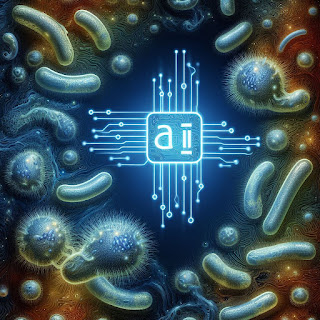 |
| Image created by Dr. Michael J. Miller |
Bacterial identification can take hours and sometimes longer, valuable time when diagnosing infections and choosing acceptable therapies. There could also be a faster, extra correct course of in response to researchers at KAIST. By educating a deep studying algorithm to establish the “fingerprint” spectra of the molecular parts of assorted micro organism, the researchers might classify numerous micro organism in several media with accuracies of as much as 98%.
Their outcomes have been made obtainable on-line on Jan. 18 in Biosensors and Bioelectronics, forward of publication within the journal’s April subject.
Micro organism-induced sicknesses, these brought on by direct bacterial an infection or by publicity to bacterial toxins, can induce painful signs and even result in dying, so the speedy detection of micro organism is essential to stop the consumption of contaminated meals and to diagnose infections from scientific samples, akin to urine. “By utilizing surface-enhanced Raman spectroscopy (SERS) evaluation boosted with a newly proposed deep learning model, we demonstrated a markedly easy, quick, and efficient path to classify the indicators of two widespread micro organism and their resident media with none separation procedures,” mentioned Professor Sungho Jo from the College of Computing.
Raman spectroscopy sends gentle by way of a pattern to see the way it scatters. The outcomes reveal structural details about the pattern—the spectral fingerprint—permitting researchers to establish its molecules. The surface-enhanced model locations pattern cells on noble steel nanostructures that assist amplify the pattern’s indicators.
Nevertheless, it’s difficult to acquire constant and clear spectra of micro organism on account of quite a few overlapping peak sources, akin to proteins in cell partitions. “Furthermore, sturdy indicators of surrounding media are additionally enhanced to overwhelm goal indicators, requiring time-consuming and tedious bacterial separation steps,” mentioned Professor Yeon Sik Jung from the Division of Supplies Science and Engineering.
To parse by way of the noisy indicators, the researchers applied a synthetic intelligence technique known as deep studying that may hierarchically extract sure options of the spectral info to categorise information. They particularly designed their mannequin, named the dual-branch wide-kernel community (DualWKNet), to effectively be taught the correlation between spectral options. Such a capability is crucial for analyzing one-dimensional spectral information, in response to Professor Jo.
“Regardless of having interfering indicators or noise from the media, which make the overall shapes of various bacterial spectra and their residing media indicators look comparable, excessive classification accuracies of bacterial sorts and their media have been achieved,” Professor Jo mentioned, explaining that DualWKNet allowed the crew to establish key peaks in every class that have been nearly indiscernible in particular person spectra, enhancing the classification accuracies. “In the end, with the usage of DualWKNet changing the micro organism and media separation steps, our technique dramatically reduces evaluation time.”
The researchers plan to make use of their platform to review extra micro organism and media sorts, utilizing the knowledge to construct a coaching information library of assorted bacterial sorts in extra media to cut back the gathering and detection instances for brand new samples.
“We developed a significant common platform for speedy bacterial detection with the collaboration between SERS and deep studying,” Professor Jo mentioned. “We hope to increase the usage of our deep learning-based SERS evaluation platform to detect quite a few varieties of bacteria in extra media which can be necessary for meals or scientific evaluation, akin to blood.”
Reference
Eojin Rho et al, Separation-free bacterial identification in arbitrary media by way of deep neural network-based SERS evaluation, Biosensors and Bioelectronics (2022).
